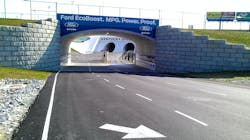After traffic nightmare, Kentucky Speedway improves access for fans
At the 2011 inaugural Sprint Cup race at the Kentucky Speedway, thousands of fans were stuck on the interstate for hours – preventing 10,000 from even reaching the race.
Just days after the 2011 race, track owners began implementing plans to improve the flow of vehicle and pedestrian traffic accessing the track. In addition to creating 20,000 additional parking spaces and adding a pedestrian tunnel under the highway, a pedestrian bridge inside the Speedway grounds was another key component of the Speedway’s plan for preventing a repeat traffic nightmare.
The 2.5:1 back slope flanking the pedestrian bridge presented a challenge for engineers designing wing walls. Poured-in-place walls were initially considered, but economics, concerns about settlement of foundation soils, plus the tight construction schedule ruled out poured-in-place walls as a viable option.
For a solution, Speedway Motorsports turned to wing walls with a reinforced positive connection system for the project.
“The project required a near vertical face, and it was taller than what could be achieved with a gravity wall because it was 21 ft at the highest point, which made the [double wing walls with a] reinforced positive connection system the best option,” said Clint Hines, P.E., of JC Hines and Associates.
The wing walls, manufactured by Redi-Rock, also had an aesthetic Limestone look. The positive connection system utilizes a corrosion-free reinforcement system without special connection components and incorporates a ¾-ton precast concrete block-facing unit.
“The flexible nature of the product allowed shallower partial undercuts beneath the walls versus complete undercuts that would have been required for poured-in-place walls,” explained Jeff Dunlap, senior geotechnical engineer at Terracon Consultants Inc.
The wing walls contained both reinforced and gravity sections. The ability to use the reinforced positive connection system and the Redi-Rock Gravity Series in the same wall allowed wall designers to minimize geogrid requirements where possible, while maintaining the same aesthetic look on the face of the wall.
“They were able to turn this project around quickly; from the time it was designed to when it was installed was less than a month,” explained Dunlap.
The actual installation of the 3,900-sq-ft wing walls took only two weeks—helping the Speedway complete improvements on their tight schedule.
Get a quote for your next project here.
